The Devil’s Cities are legendary landmarks on the northwestern plains of China, ever-changing and awe-inspiring, resembling cities built and inhabited by demons.
Yardang landforms are considered the royalty of the arid northwest regions. They are widely distributed across the northwestern Qaidam Basin, the middle and lower reaches of the Shule River, and the Lop Nur area. The ancient Silk Road, which connected the ancient kingdoms of the Western Regions, traversed these territories.
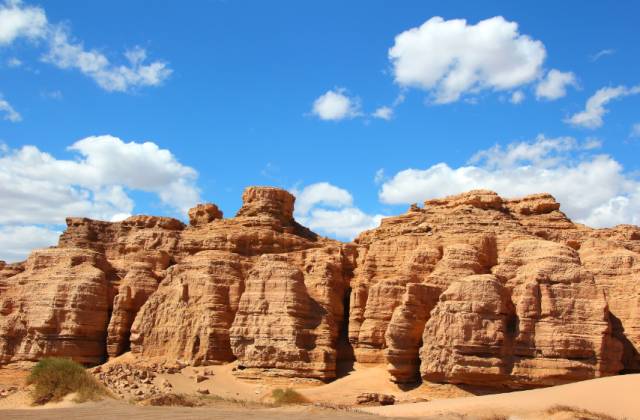
The unpredictable nature of yardangs makes them incredibly diverse. In some places, they appear as if touched by a magic wand, resembling elephants, peacocks, or camels standing guard on the wasteland. At other times, they transform into countless stretching dragons, known as the “Array of Ten Thousand Dragons.”
Regardless of their form, they are filled with “magnificent poetry,” inspiring endless wonder and speculation in those who encounter them. Camel caravans with tinkling bells, travelers to and from the Western Regions, and Buddhist monks on pilgrimages have all expressed their awe of these majestic formations through numerous records and fantastic legends.
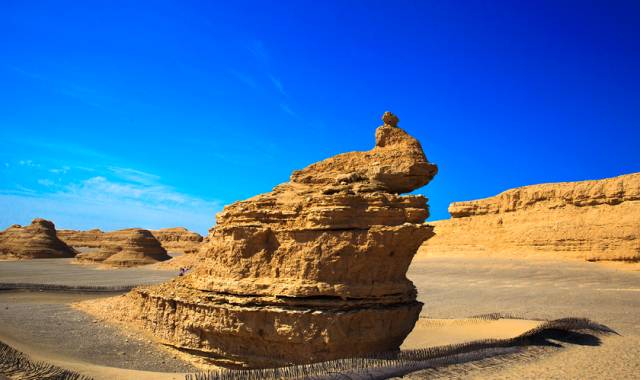
In the Northern Wei Dynasty, Li Daoyuan created a legend of a dragon city for the White Dragon Mound yardangs in his work “Commentary on the Water Classic.” He wrote, “The Dragon City is the ruins of the great Hu nation. The Puchang Sea overflowed and submerged the country. One could depart from the west gate in the morning and reach the east gate by dusk.”
He regarded it as the remnants of a great Western Region nation, destroyed by the flooding of Lop Nur. This may not have been a deliberate fabrication, as the yardang Devil’s Cities do indeed resemble ancient cities. The complexity of their “streets” is beyond description, but according to one scientific expedition record, with the help of a GPS system, a desert off-road vehicle only managed to progress 11 kilometers in two hours, making 186 sharp turns.
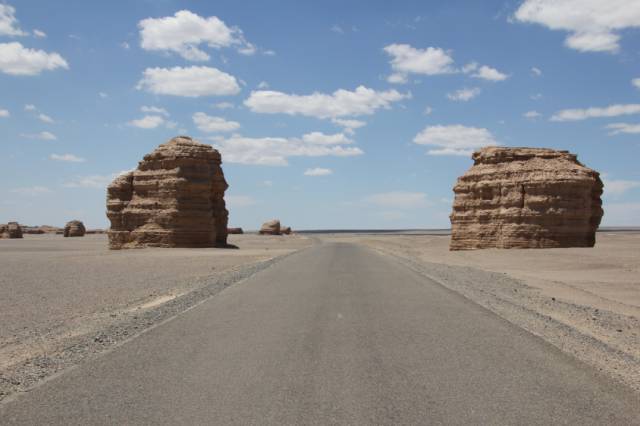
In “Journey to the West,” the monk Xuanzang encounters a river of shifting sands where “goose feathers cannot settle, and reed flowers sink to the bottom.” Where exactly is this river of shifting sands?
While researching northwestern yardangs, I came across a news article stating that in 1980-1981, after multiple surveys of the Lop Nur area, scientists from the Chinese Academy of Sciences discovered the real “800-li River of Shifting Sands” in the Sanlong Sand area outside Yumen Pass. However, it wasn’t a raging torrent, but rather hundreds of miles of east-west stretching yellow sand that rolled with the wind.

The “stronghold” guarding this river of shifting sands is the Dunhuang Devil’s City, located near Sanlong Sand, which I have visited. It is massive and imposing, with light brown mounds about 2-4 stories high, each stretching for 200-300 meters.
In the depressions between the mounds, rolling sand forms ripples like small, rushing rivers. For thousands of years, violent winds and water have eroded the once-flat land by 10-20 meters, creating countless shifting sands that feed into the “800-li River of Shifting Sands.”
In the early 20th century, Swedish explorer Sven Hedin even believed that the wind-eroded products of yardangs were the main source of replenishment for the Taklamakan Desert after his expedition to the Lop Nur region.

Lop Nur is the “governing center” of the Yardang Devil’s Cities. Beyond the peripheral Sanlong Sand area, as you venture deeper into the “demon realm,” you’ll encounter the White Dragon Mound Yardangs, Loulan Yardangs, and Dragon City Yardangs. The transformations of yardangs are infinite, with 72 variations capable of astonishing anyone.
The White Dragon Mound Yardang Devil’s City is massive, stretching approximately 20 kilometers from east to west and 80 kilometers from north to south. It primarily developed on a foundation of grayish-white sandy mudstone interspersed with gypsum layers. From a distance, it resembles white dragons coiled in the desert, like the layered defenses of the Loulan Kingdom, exuding the aura of a “frontier stronghold.” The Dragon City Yardangs and Loulan Yardangs are more lively “small cities,” with light brown upper layers, hints of grayish-green in the middle, and earthy yellow at the bottom, showing some color variation. These mounds are only a few meters high, resembling common dwellings. The sporadically distributed Achik Valley Yardangs can be considered “rural villages.”
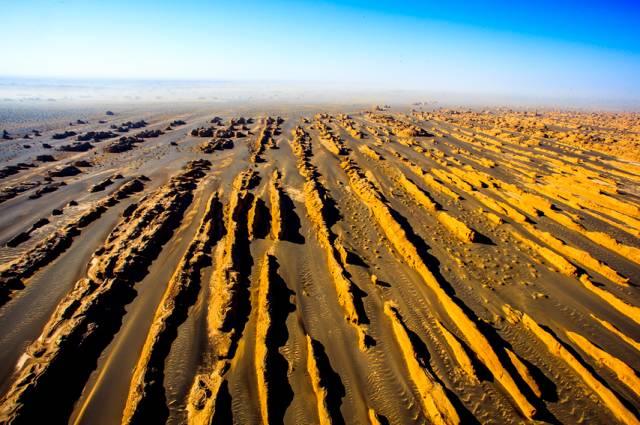
The Devil’s City’s transformations go far beyond this. Under the sculpting of wind and water, the yardangs’ youth, maturity, and old age stages display countless postures, much like the rise and fall of a city.

Traveling across the Lop Desert, one often hears sudden “crackling” sounds, resembling firecrackers. This is the Devil’s City undergoing “municipal construction.” The area experiences extreme temperature fluctuations between day and night. Under the scorching sun, midday ground temperatures can reach 70°C, with heat waves strong enough to melt candles inside tents.
The expansion and contraction due to temperature changes cause the harder surface layers of yardangs to crack, making noise and gradually exposing the softer sand layers beneath, creating conditions for further shaping of the Devil’s City.

In the 1930s, Chinese scholar Chen Zongqi and others surveyed Lop Nur and classified yardang landforms into two types: those less than 1 meter high and of recent formation, called yardangs; and those 10-30 meters high and of ancient origin, called maisai. In reality, these are simply the early and advanced stages of yardang development. Near the ancient city of Loulan, there is a patch of youthful yardangs that from a distance resemble low, broken walls or tombs. As wind continuously blows and erodes along the crevices, it may eventually transform into a majestic ancient city.
Due to the small-scale Venturi effect created by wind erosion in the gullies, which enhances erosive power, the development of yardangs from infancy to maturity and from maturity to old age is relatively rapid, possibly taking only several hundred to a thousand years. When they appear before us in their myriad forms as vivid, isolated mounds, they are already the aged remains of yardangs. At this stage, they begin to display a resilient character, capable of standing in the wilderness for thousands of years without falling.
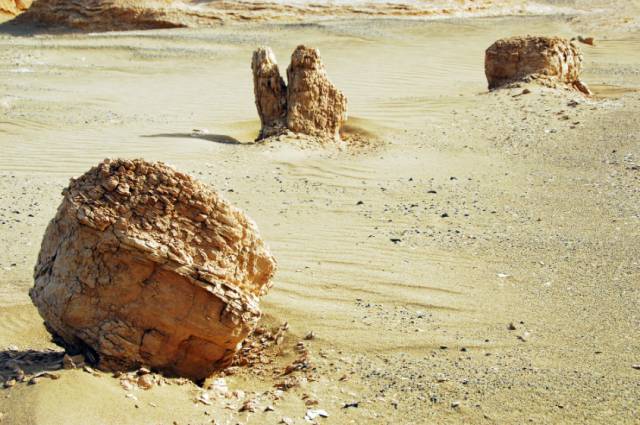
The northwestern Qaidam Basin boasts China’s largest Yardang Devil’s City. In satellite images, it resembles a series of ellipses. Delving deeper, you can observe more of the 72 variations of yardangs – square mountains, canine tooth-shaped, pyramidal, long ridge-shaped, and whale-back shaped, all filled with magical and bizarre colors.
According to a research report by a European scientific explorer who ventured into Qaidam, these formations have complex transformation relationships. For instance, square mountains may evolve into pyramids or flat-topped towers, while canine tooth-shaped yardangs might be the “prototypes” for conical or whale-back yardangs.






